Want to create a flexible work environment?
A flexible work environment offers many benefits — from increased productivity and cost savings to a better work-life balance.
And while managing a flexible work arrangement can seem challenging, it doesn’t have to be. After all, proper tools, guidance, and execution are all you need.
In this article, we’ll cover what a flexible environment is, its benefits, along with five steps to create a flexible workplace.
We’ll also highlight a few tips to ensure workplace flexibility.

Table of Contents
- What is a flexible work environment?
- What are the flexible work options?
- 3 key benefits of having a flexible work environment
- 5 simple steps to create a flexible work environment
- 5 proven tips to ensure workplace flexibility
Let’s get started.
What is a flexible work environment?
A flexible work environment isn’t bound to rigid rules and functions on flexible guidelines.
It revolves around a few aspects like:
- When a worker begins and ends their shift.
- Where they work from.
- Circumstances under which emergency leaves are allowed.
- The permitted number of days for remote work.
However, a flexible work environment is more than just creating flexible work hours. It requires equal participation from both employees and employers.
How?
Employers need to adapt to employees’ changing needs and approach towards tasks. They need to trust employees with their assigned work.
On the other hand, employees need to fulfill their commitments.
This helps build mutual respect and is a huge motivation that delivers positive results like higher employee morale, productivity, and retention.
Moreover, allowing your employees a little freedom on how they tackle tasks can help in delivering better results and increase employee satisfaction.
What are the flexible work options?
Let’s take a quick look at various flexible work arrangements:
1. Flextime
Flextime refers to completing the required number of hours but with flexible start and end times.
For example, an employee can clock in 6 hours of workday anytime between 8 A.M. and 8 P.M.
2. Compressed workweek
A compressed workweek schedule allows employees to cover full-time hours over fewer days.
For example, an employee can work 10-hour days for a four-day workweek.
3. Job sharing
In job sharing, two part-time employees are assigned the same job that covers one full-time employee’s requirements.
4. Reduced hours
In a reduced hours schedule, employees work for fewer hours than the standard workweek while the salary is adjusted accordingly.
Usually, this type of arrangement is a switch from a full-time position to a part-time one.
5. Telecommuting
Telecommuting allows employees to split their working hours between home and the office.
In some cases, an employee can also work full-time away from the office.

3 key benefits of having a flexible work environment
Let’s take a look at a few common benefits of having a flexible work environment:
1. Increased productivity
A traditional work arrangement follows standard working hours, providing limited flexibility.
Usually, employees must comply with the company’s nine to five work schedule regardless of their productivity levels.
This might restrict their ability to efficiently manage their work and personal life leading to unhappy and unproductive employees.
However, employees can plan their workday with a flexible schedule according to their needs — choosing their preferred work hours. They can work when their productivity is at its peak and in surroundings that are suitable for them.
Additionally, flexible hours provide employees more time to handle unavoidable situations that can sometimes lead to absenteeism.
2. Save time and money
With a flexible work environment, you don’t necessarily need your entire workforce to be working from the office.
This means your company can function in a relatively smaller office space and help you save on things, like:
- Office rent and maintenance.
- Utilities like electricity and the internet.
- Transportation services.
- Food and beverages.
However, the benefits are not only limited to the employers.
Employees who work in flexible work environments save both time and money on their daily commute. They also avoid the hassle of traveling during peak office hours, which can be physically exhausting.
2. Better work life balance
Flexible working hours allows your employees to have better control of their life.
With a flexible work option, employees can:
- Spend more time around their family and friends.
- Practice hobbies and other interests in their free time.
- Pick/drop their kids at childcare if they’re a working parent.
Additionally, creating a flexible working environment helps employees easily balance their work and home activities.
Having this balance also increases job satisfaction which translates to increased employee retention.
5 simple steps to create a flexible work environment
Here are five easy steps to create a flexible work environment:
Step 1: Set the right motivation
While giving your employees some financial incentives can increase their motivation, it’s not the strongest approach to do so.
Many employees aim to sharpen their skills, strengthen their potential, or simply gain more experience.
That’s why it’s essential to create a work environment that promotes personal growth and supports their aspirations.
To do that, you need to identify and devise team-specific incentive strategies.
You can try a few things, like:
- Give your employees the flexibility to try new approaches for tasks.
- Challenge your employees with complex tasks.
- Invest in programs and courses to boost their skills.
- Keep your employees engaged to strengthen their potential.
Step 2: Set up a flexible work policy
Guidelines and policies can help avoid confusion and help your team adapt to workplace flexibility quicker.
Some of the essential work policies you’ll need for a flexible arrangement are:
A. Work from home policy
An effective work from home policy covers the various aspects of remote working. This ensures both the employer and employees know what is expected of them.
The policy should clearly detail topics like:
- Who are eligible to work from home.
- The standard procedure to request work from home.
- Required working hours.
- Proper communication channels.
Check out how to draft an effective work from home policy.
B. Web security measures
Office networks are more secure and protected.
However, if your employees are working remotely, monitoring data security can be difficult.
You can establish a few data security measures that can be included in the work from home policy, like:
- Use a secure internet connection or a VPN (Virtual Private Network).
- Don’t use public WiFi networks for official purposes.
- Don’t discuss confidential company information over calls in public.
- Avoid visiting websites or apps that violate company policies.
C. Employee monitoring policy
When managing a remote workforce, it’s difficult to know when your employees are working or on what and how much time they spent on it.
An employee monitoring policy can help address these concerns and monitor your remote worker.
It can include topics like:
- Objective or purpose of the policy.
- Types of surveillance methods used.
- Who is being monitored and when.
Here’s how to create an excellent employee monitoring policy.

Besides the ones we covered above, some other essential work policies include:
- Flexible work schedules policy.
- Computer usage policy.
- Telecommuting policy.
- Remote work policy.
- Social media policy.
- Employee attendance policy.
Step 3: Allow remote work
Flexibility to work remotely ensures that all employees are not required to work through 9-5 and can work when they’re most comfortable.
Remote work allows your employees to work during their productive hours, manage their personal lives, and save time for themselves.
They also save time and money on the daily commute and work from the comfort of their homes. This can invoke a feeling of happiness, making them more dedicated to their job.
Another way to go about this approach is to introduce Hot Desking.
What’s Hot Desking?
Hot Desking allows employees to set camp anywhere in the office that suits their everyday tasks the best.
This helps reduce the number of work desks needed, especially when employees are not working full-time or spend most of their time outside office meeting halls.
Step 4: Build team relationships
The more work flexibility you offer, the more likely it is for your employees to interact, be familiar or even share ideas.
As a manager, it’s important to ensure your team members frequently work together and bond. It establishes a sense of familiarity and respect for each other.
You can try a few activities like:
- Have virtual get-togethers where they can talk about things outside of work.
- Create an informal Slack channel to cover for actual water-cooler conversations.
- Conduct team-building exercises like Break The Ice.
- Substitute regular meetups with virtual pizza or taco parties.
- Schedule a few minutes for casual discussions before weekly reviews.
Employees who are comfortable with each other and work well as a team are quicker and better, which simply translates to increased productivity.
Check out virtual team-building activities for your remote team.
Step 5: Conduct trial runs
Before deciding to implement a flexible working environment throughout your organization, it’s always better to conduct a few practice runs — especially if you’re a large organization.
Why?
These test runs can help you better understand how your team operates under flexible working conditions. It also enables you to deal with unexpected problems at a smaller scale which could’ve been difficult otherwise.
You can either try implementing the policy in a few departments or have a trial run for a good amount of time.

5 proven tips to ensure workplace flexibility
Now that you know how to create a flexible working environment, let’s take a look at a few tips that can help you ensure flexibility in the workplace:
1. Get started as soon as possible
Setting up a flexible work program is easier said than done.
Both the organization and its employees need to be mentally prepared to adapt to the changes.
This can include establishing a few things like:
- Standard medium of communication.
- Required number hours to be met under flexible scheduling.
- Workdays that require the employee to be physically present, and more.
For example, if you’re going to implement flexible work hours, you can suggest a few common business hours during which all the employees need to be present.
2. Be mindful of the learning curve
Implementing a flexible work schedule can bring a new set of challenges each day.
That is why it’s important to ensure that flexibility in the workspace doesn’t come at the expense of productivity or work quality.
Training managers and team leaders ahead of time can help them tackle challenging situations better.
For example, you can advise them to leave some lead time to fix any unexpected errors. And as these errors can be anyone’s fault, it’s wise to be patient.
3. Encourage feedback and communication
Effective communication is the key to a flexible work environment.
Communicating ideas and goals effectively helps foster a culture of transparency, trust, and collaboration.
This also helps you understand your workforce and identify their skills better. You can then pick the right people for tasks — boosting efficiency and productivity.
Moreover, as employees get more familiar with newer working methods, you can encourage them to offer constructive feedback to help improve the policy norms.
And then, you can implement the necessary changes to meet the needs of your company and employees.
4. Ensure good management
Poor management can lead to high employee turnover.
Managers who fail to inspire their team members or lead their team can lower employee morale and weaken their trust.
A few signs of poor leadership are:
- Micromanagement.
- Picking on employees’ mistakes.
- Lack of empathy for their team members.
- Absent leaders who don’t take the initiative.
However, leaders who empathize with their team members’ problems or simply guide them in the right direction help create a positive workplace culture.
Moreover, to ensure good management, you can regularly evaluate managers’ performance through employee feedback. You can also invest in the leadership development skills for managers to train them for their job roles.
5. Provide the right tools
Work flexibility also means your employees should be well equipped with the right tools to cope with remote work and its challenges.
Fortunately, productivity monitoring tools like Time Doctor can help you with a lot of your problems.
What is Time Doctor?

Time Doctor is a workforce analytics software used by large companies and small businesses to boost their team’s productivity.
Here’s a quick look at its features:
- Manual and automatic time tracking.
- Powerful performance reports for a detailed breakdown of time expenses.
- Productivity ratings to rate websites and applications based on their productivity levels.
- Idle time tracking for better employee productivity monitoring.
- Chrome extension to track time spent on other online applications.
- Payroll management to generate employee payroll hassle-free.
- Third-party app integration with several business tools like Asana and QuickBooks.
Wrapping up
Whether you’re an employee or an employer, there are upsides to a flexible working arrangement.
A flexible work environment helps you save money, boost productivity, along with a better work-life balance for your employees.
But remember, you can’t take advantage of the benefits without proper execution, so carefully go through all the details mentioned in this article.
Once you do, you’ll have no trouble setting up a flexible work culture and managing it!

Liam Martin is a serial entrepreneur, co-founder of Time Doctor, Staff.com, and the Running Remote Conference, and author of the Wall Street Journal bestseller, “Running Remote.” He advocates for remote work and helps businesses optimize their remote teams.


